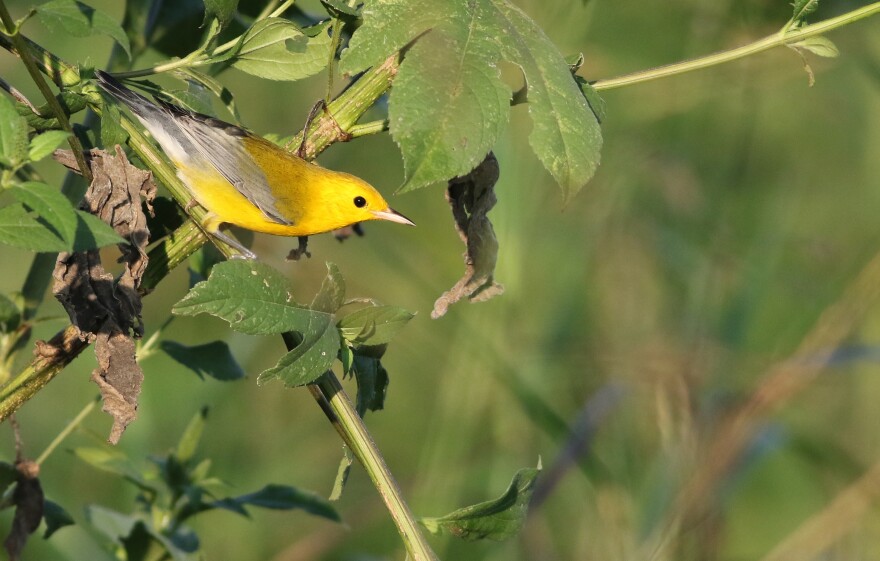As the word “birdwatching” suggests, having attentive eyes is a crucial part of this hobby. Well-trained ears, too, are helpful for detecting species hidden from view. Jim Varner and his friend, Bob Foehring, rely on both.

“There’s a Yellow-breasted Chat," Varner calls out during an outing last spring. "He sounds like an old man laughing.”
But here at the T.E. Maxson Wastewater Treatment Facility complex in South Memphis another of the five senses is also an unavoidable part of the hunt: smell.
“It reminds me of [a] junior high football locker room when you were playing two-a-day practices in the summer,” Varner says with a wide grin.
That is to say, the location has a distinct odor. While elements of the sewage treatment process would most certainly be unappealing for the general public, it's useful for birds. In fact, they flock here for food and shelter, which means recreational birdwatchers—or birders as they are known— do as well to see them in action.

The area is called Ensley Bottoms, or “The Pits” for short, and is one region’s most enticing hotspots for those with binoculars and spotting scopes. The site consists of a series of lagoons, or settling ponds, containing biosolid muck.
“It makes these incredibly heavily vegetated, but very shallow and mud flat-like areas,” says biologist Jerad Henson, who studies ducks on the premises.
The expanse creates a kind of artificial wetlands, Henson says, where the byproducts of human waste create a nutrient-rich farm for avian diets.
“There are tons of insects in this as well,” he says. “Lots of invertebrates — so bugs, worms, things like that. And then, tons of seeds.”

It’s a veritable buffet for birds, albeit one with a stinky downside for those who come to observe them.
Some liken the smell to that of a strong fertilizer. Foehring says the fragrance is more unpleasant on some days than others, but you get used to it.
“One of the nice things for birders is the sense of smell adapts out quicker than almost any sensory system,” he says. “You still can notice because this is pretty pungent, but it’s nothing like when you first get out of the car.”

Foehring, 68, is a retired neuroscientist and has been birding here for decades. Varner, a 68-year-old retired orthopedic surgeon, picked up his binoculars about six years ago. As the annual spring and fall migration seasons unfold, they’ll often frequent the site on a weekly basis.
They tolerate the nose holding and even the flies that sometimes follow them home, because Varner says the birding is just that good.
“There have been well over 300 species seen here at some time,” he says. “Some are great rarities and some are here on a regular basis.”

One reason for such diversity is geography. Millions of migratory birds pass through this region following a path known as the Mississippi Flyway. Some trek from South America to as far as northern Canada and back.
For these hungry flyers, The Pits are a prime pit stop for refueling.
“They’ll lose a large percentage of their body fat, even burn protein, muscle,” Foehring says. “They very quickly will reverse that on feeding and so these areas that are rich in food are really important.”

During migration, birds can also make navigational errors, creating opportunities for unexpected visitors. Foehring’s most memorable sighting of an off-course globetrotter happened in 1992, when a Sharp-tailed Sandpiper, a bird that typically transits from Australia to Siberia to breed, somehow found its way to these ponds in Memphis.


“There’s range and seasons to birds, and when they get out of the confines of what’s normal, geeks like us get real excited,” Varner says.
The major attraction for birders at Ensley Bottoms is a group of long-distance travelers known collectively as shorebirds. Foehring says at the height of their migration, thousands of these sandpipers and plovers can be seen picking and probing the mud.
“Experienced birders love shorebirds,” he says. “Inexperienced birders hate shorebirds because they kind of all look alike.”
But flashier species drawn to the area’s surrounding woods, grasslands and marshes also abound. Varner says the vibrant golden plumage of the Prothonotary Warbler, for example, should grab a beginner's attention.
“If you’ve never seen one, and you see one and don’t take up birding, you need to really check and see if you have a soul,” he says.
It takes a committed soul to explore these pits. The first time Mohua Lahiri and her husband Anupam came, they almost turned around.
“But then, we went back to the car, got our masks, and the masks helped some, and we were happy we came,” Mohua says.
Now they come multiple times a year to hone their bird photography skills.
“Here it’s always some surprises,” she says. “Something new.”
It’s this birding kaleidoscope that lured Cliff VanNostrand to the spot. He took up birdwatching several years ago for its mental health benefits.
“It’s helped me appreciate the world around me better, to be more observant,” he says. “There is a rhythm to [birds’ lives] so this has kind of helped me restore some rhythm to my life.”
After he discovered Ensley Bottoms, he also learned it’s not just a calm state of mind and fond memories that stick with him upon leaving.
“When I get home, you know, everything goes in the wash, and I take a shower,” he says.
But it’s worth it, he says. Afterall, the stench comes — and goes — with the territory.
Varner says birdwatchers are welcome at Ensley Bottoms, but that they need to be aware and respectful that the city-owned property is also a worksite. He says first timers should contact the Memphis Chapter of the Tennessee Ornithological Society, and they’ll provide a tour and tips on being a mindful observer.



